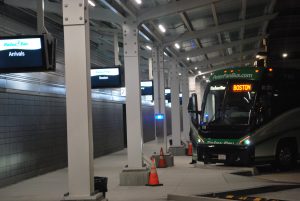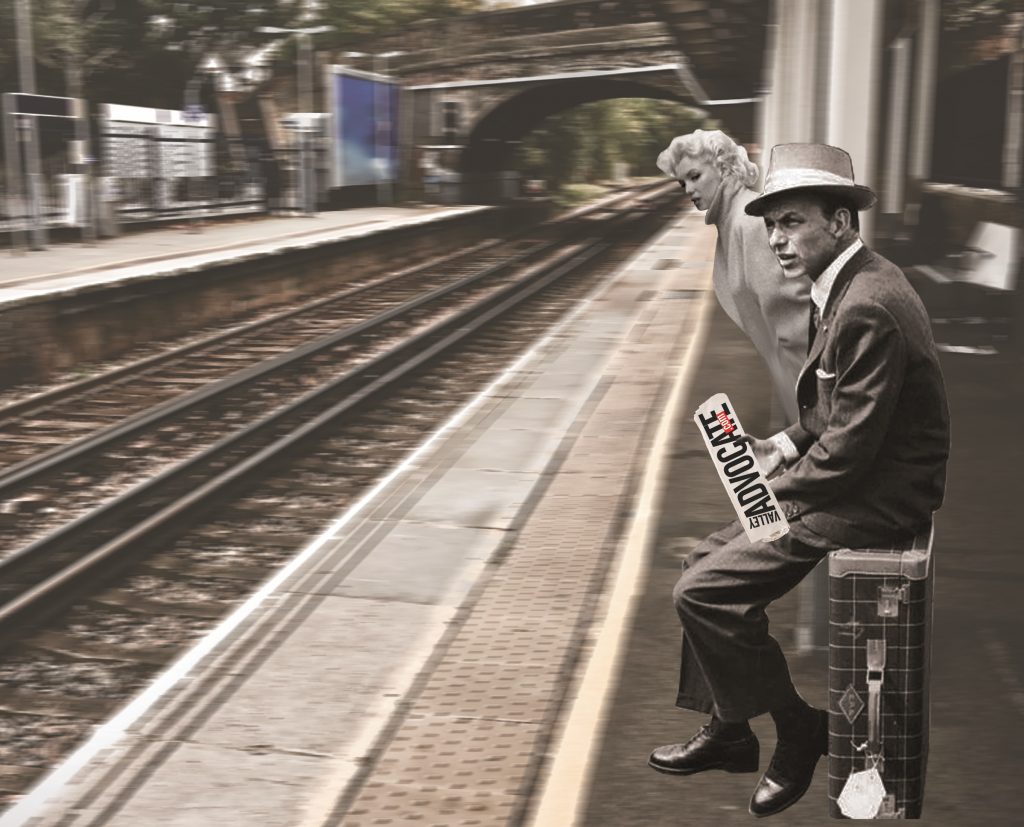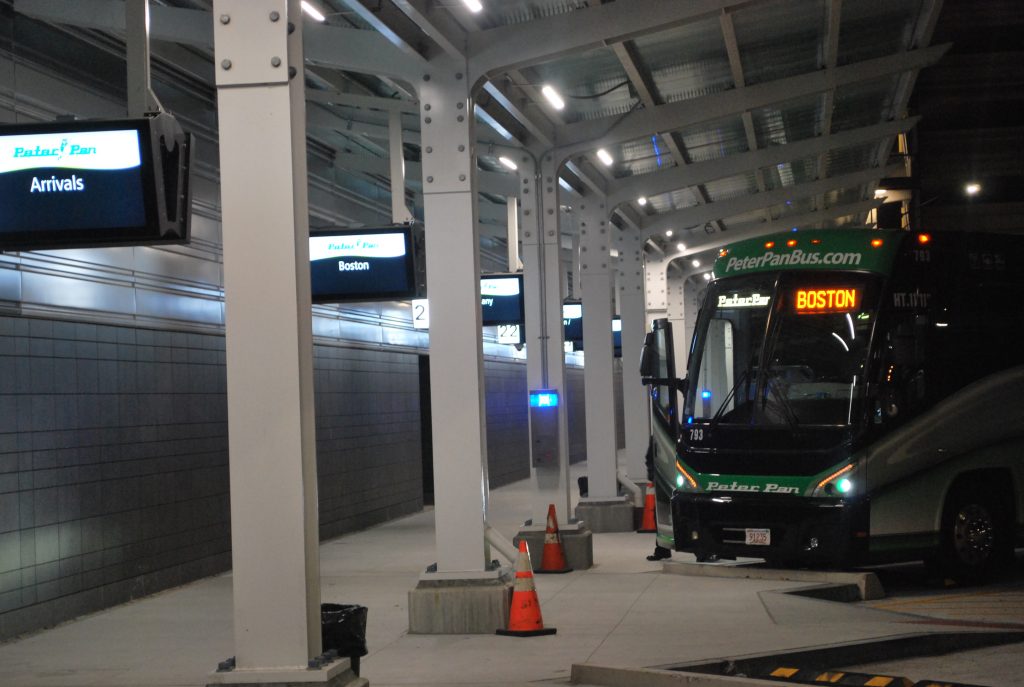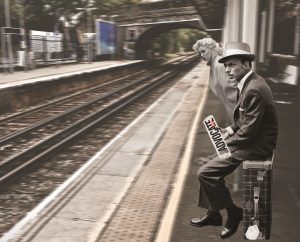Jim Emerson, 53, wakes up at 5 a.m. three or four days out of the work week to make the commute from his home in Wilbraham to Boston. He’s typically out the door around 5:45 a.m. and is on the road driving east on the Massachusetts Turnpike for 50 minutes in his 2016 Ford Fusion Hybrid to catch an hour-and-a-half-long train ride from Worcester.
“I’ve traveled for work nationally and internationally. I’ve seen rail systems and transit systems all around the world. By far, we’re one of the worst. We’re at the very bottom,” said Emerson, who works as a risk assessment engineer for Starr Companies, a global insurance and financial services company.
Maryalice Moran, a resident of Belchertown, said she used the Mass Pike to get to Dana Farber for her husband’s chemotherapy treatments.
“The traffic on [the] Mass Pike was just terrible,” she said. “We live in Belchertown and it generally took over two hours to get home after treatments. High-speed rail would have helped us in this stressful time.”
But what if Emerson, Moran, and others could have their commute to Boston cut to just over an hour? State Sen. Eric Lesser (D- Longmeadow) thinks and east-west high speed passenger rail could make that a reality.
However, there are challenges for the high-speed rail project. A feasibility studying needs to be funded in order to assess how much the project would cost, whether it would be logistically feasible to use existing rails, and how the project could obtain a right of way from CSX, which owns the railroads from west to east in Massachusetts.
Riding the Bus

An early-morning Peter Pan bus sits in Union Station at 5:15 a.m. on Oct. 18. The bus is now one of the only ways to get to Boston. Chris Goudreau photo
One bus sat at the newly reconstructed Union Station in Springfield at around 4:40 a.m. on Oct. 18. The Peter Pan bus was scheduled to leave for Boston at 5:15 a.m. and three people sat under bright lights inside the station waiting to get on the bus. Outside the station there was pitch blackness, the roads were barren of vehicles, and only the occasional sound of passing cars was to be heard.
Other early morning bus lines to Boston include a Greyhound bus that leaves at 8:40 a.m. and another Peter Pan bus that leaves the station at 8:15 a.m.
James Williams, 71-year-old Springfield resident, waited nearby the bus port with his backpack on the ground beside him. He told the Valley Advocate he was planning on visiting family in Boston and occasionally takes the early morning three-hour bus ride for work in the state capital.
“I was just in sales, that’s all,” he said. “I’m just going up to visit now … Right now, I take [the bus] once a month.”
He said the commute takes three hours due to frequent stops to pick up passengers in Worcester, Framingham, and near the state house.
“We get to South Station about 8 o’clock,” he said.
Williams said he thinks the idea of a high speed rail connecting Western Massachusetts with the eastern half of the state would be beneficial to him.
One woman who was waiting for the bus said she works in Boston, but declined an interview. Only she and Williams got on the bus a little after 5:05 a.m. as the station’s earliest bus got ready to make it’s three hour long journey to Boston.
The Fight To Study Rail as a Possibility
Before a high-speed rail project could be seriously considered by the state, a feasibility study would need to be completed.
Sen. Lesser is the sponsor of a bill calling to fund the study, which would determine how much money would be needed to create high-speed rail in the state, the annual operating costs and revenue estimates, what upgrades to existing rail infrastructure would need to be made, the environmental impacts of the project, projected ridership levels, whether existing rail rights of way could be used, and if would be a project that would be beneficial to citizens across the commonwealth.
“Once the feasibility study is done, we have an actual real blueprint of how to make this project a reality,” Lesser said. “Then we can begin the process of getting state funds; of getting federal dollars.”
The proposed high speed rail could go at least 70 miles per hour and might be much faster at different points along a route, Lesser said. But no one can know for certain how fast the train could zoom through the commonwealth unless the study is completed.
For the past three years, Lesser has filed the bill and it has received bipartisan approval in the state Senate, but it has yet to get final approval. In 2016, Gov. Charlie Baker vetoed the study from the budget.
Peter Picknelly, owner of Peter Pan Bus Lines based in Springfield, said he lobbied Baker and Western Massachusetts legislators in 2016 via email and asked them to consider studying transportation alternatives in addition to high-speed rail.
“We didn’t send it covertly to Baker,” he said. “We sent it to the entire Western Mass contingency as well,” he said. “Every single legislator in this area got a copy of it. We simply said, ‘If you’re going to do transportation improvements between Springfield to Boston, allocate some funds to other alternatives. Don’t take one myopic look at trains.’”
Picknelly said the reality of implementing high-speed rail or any improved train service is likely years away.
“There are things that you could do immediately that could improve transportation from Springfield to Boston – reverse commuter lanes, use of break down lanes during commuter hours – things like that could be included in the study,” he said.
Picknelly said he thinks the state should adopt a customer pass for public transportation across the state that people could use for trains, buses, and subways.
In 2017, Lesser gained 25-cosponsors on the study bill, including Republicans and Democrats from the House of Representatives and the Senate. It was also endorsed by the Boston and Springfield Chambers of Commerce.
However, during a closed-door budget negotiation meeting with members of the House of Representatives in July, the bill was dropped from the final budget without explanation, Lesser said.
“People were really outraged and frustrated when that happened with no explanation; with no context; with no background,” Lesser said. “This was after it had already passed the Senate three years in a row. … I’m prepared to file it every single year I’m in office.”
Senate President Stan Rosenberg (D-Amherst) declined to answer a question about whether he thought any lobbying from businesses contributed to the study being cut from the 2017 state budget.
“The budget conference process is a closed process among the six people at the table,” Rosenberg said, referring to the fact that the state’s Open Meeting Law does not now cover this process. “They have to make hundreds, if not into the thousands of decisions, as they reconcile the differences between the House and the Senate versions of the budget. You’re never going to know who said what or who did what. So, that’s now the past.”
Despite the study’s lack of funding this year, Lesser is still championing high-speed rail. He invited a bus full of local legislators and constituents to a Joint Committee on Transportation hearing regarding his bill on Oct. 24 in which Pioneer Valley residents testified about their own experiences making the more than 2-hour trek to Boston and how high-speed rail could impact their lives.
Lesser also launched a website earlier this month called, “Rail Matters,” in which people living in Massachusetts can share their own stories.
Wendy Deshais, a resident of Palmer, said she has two adult children living in Worcester and Framingham, one of whom doesn’t drive.
“Whenever she comes to visit, I must drive two hours to bring her home to my home for the day, then another two hours round trip to bring her home,” she said. “The traffic on the Mass Turnpike sometimes turns those two-hour trips into three-hour nightmares. As I get older, I find the drive becoming more difficult every year.”
She said train service from Palmer would likely open up the town’s housing market to people who work in the eastern half of the state.
“I would love to visit my family more often, and rail service from Western Massachusetts would allow me to do so,” Deshais said. “Once again, the taxpayers west of Worcester seem to be forgotten by Beacon Hill. When will our voices be heard in the Commonwealth?”
Creating an east-west exchange in Massachusetts
There are more high paying jobs in the Boston area compared to the Pioneer Valley, but Western Massachussetts has more room for growth and cheaper housing compared to the eastern half of the state. Using public transportation to connect the two halves of the state could be a mutual benefit.
“We’re not producing enough high paying jobs to keep our families here,” Lesser said. “So, rail would create an exchange. Boston [residents] would get access to a lower cost of living and lower priced housing. Western Massachusetts would get access to high paying jobs in fast growing fields.”
The city of Springfield has seen a lot of growth during the past year. A $94 million renovation of the 1926 constructed Union Station was completed this year, which includes Peter Pan and Greyhound bus lines and planned commuter rail service on the Hartford Line in 2018.
The state is also developing a “21st Century Transportation Vision,” which recently completed its first stage. Nine regional meetings were hosted across the commonwealth in which more than 700 people attended. The plan would investigate expansions to all modes of public transportation from busing to high-speed rail.
Rosenberg, who is a co-sponsor of the vision plan, said the findings from the meeting showed that Massachusetts residents want more public transportation that’s environmentally friendly and affordable.
“They realized that we have to fix the roads and bridges, but we also didn’t want it to come at the expense of expanding public transportation in the state,” he said. “When it came to paying for it, they were pretty equally divided between people who wanted broad-based taxes versus user fees, which would include things like the gas tax or tolls or fares. A lot of people were open to both.”
Any mode of transportation that reduces the number of cars on the often congested Massachusetts Turnpike would be a boon for the state, Rosenberg said.
“That means you could be doing [high occupancy vehicle] lanes, where there’s two or more people in a vehicle instead of one person in a vehicle,” he said. “You could do buses; you could do dedicated bus lanes; and you could do trains … In my opinion, you have to be able to think about all of the options.”
Lesser said he’s not opposed to increasing bus services from one side of the state to the other, but thinks passenger rail would be a better option because it would take more vehicles off the roadways.
Picknelly said MassDOT is already looking into high-speed rail and believes Lesser’s study would duplicate efforts.
“This is a sound byte for Eric Lesser to simply get his name in the newspaper and in the media,” he said.
Lesser responded by stating, “He should tell the families that have to move out of Western Mass because they can’t get connected to jobs in Boston or tell the families of people who have to go to Boston for medical treatment or cancer care that this is just a sound byte.”
Lesser said he’s been working with MassDOT, as well as the state and federal government to make sure his bill is integrated into the state’s rail plan.
“The fact of the matter is the state of Massachusetts hasn’t made this a priority or else the study would be done already … If they decide to do it on their own, great. But if not, we have this legislation to make sure that they give Western Massachusetts its due,” Lesser said.
The wider region
Gretchen Markiewicz, a resident of Walpole, N.H., located north of Keene, works as a software engineer at Raytheon BBN Technologies in Cambridge. She travels about three hours to work once per week to get to the city.
Here’s how her work day starts: she’s up at 6 a.m. and leaves home at 6:45 to catch the 8:08 Fitchburg train to Porter Square in Cambridge. Then she takes the T in Boston to the Alewife stop and walks the rest of the way to work, often getting in the office at around 9:45 a.m.
“It’s more doable because I only do it once a week, but it does make for a long day on the day that I go in,” she said. “I work remotely the other days of the week.”
Markiewicz said she thinks high speed rail options from one side of Massachusetts to the other would allow a better connection to Boston and be a better option for working professionals all over the region who commute.
“It would really help those communities that are smaller; to keep them stronger and have them as options for people who might go to Boston for school and then are able to come back and keep the network connections that they’ve made for Boston,” she said.
When she first moved to Walpole in June from the Greater Boston area, she often used the MAX Regional Bus, which starts in Brattleboro, Vermont, makes stops in cities such as Greenfield, Worcester, and Framingham, before reaching Boston. However, the MAX Regional Bus service was shut down in June.
The MAX Regional Bus website states that Massachusetts Department of Transportation (MassDOT) funding was cut in September 2016 across the state, which led to the decision to suspend the bus service.
Massachusetts has seen improvements with its north to south commuter rail service in recent years, which includes stops in Northampton, Holyoke, and Greenfield. There are even plans to expand passenger rail service in Northampton, which is the third busiest stop along Amtrak’s Vermonter line, which runs from Washington D.C., north through Massachusetts, to St. Albans, Vermont.
Cutting a deal with private industry
One of the biggest challenges for high-speed rail is acquiring the right of way for the rail tracks, said Dana Roscoe, principal planner for the Pioneer Valley Planning Commission.
“The ownership of the existing line belongs to CSX [Transportation],” he said. “CSX is a private entity that is operating today and will continue to operate into the future. It’s improbable that there would be any incentive for CSX to invest in its own infrastructure to make its freight trains move faster because their commodity is not as time sensitive as a passenger rail.”
Roscoe said all the rails from Springfield to Boston are owned by CSX.
Lesser said a deal would likely need to be struck between the state and CSX for the tracks to be shared.
“You would do double tracking along the way to expand the capacity so that both freight trains and passenger trains can operate,” he said.
It’s also unlikely that a high-speed rail from Springfield to Boston would be able to use the existing rail infrastructure near Worcester due to the hills in the region, Roscoe said. Trains along the route to Worcester move in zigzag direction in order to travel across inclined areas. The trains need to reduce their speed as they make turns. A high-speed rail needs a path that is relatively straight in order to maintain high speeds.
“Every time the train turns, it has to slow down. It can’t maintain speed and go through those turns,” he said. “The way to combat that would be to a straighter flatter track.”
Lesser said this logistical challenge for the project would be examined in the feasibility study.
“All of those things are ultimately surmountable,” he said. “We built trains through the Rocky Mountains … We’ve done complicated infrastructure projects before.”
Another challenge to the project is the current capacity at South Station in Boston, which might not be able to handle increased rail service.
Lesser said there’s been discussions of moving a postal facility that abuts South Station to free up land for extra track space. Another legislative proposal would be to connect North and South stations in Boston to gain more track space.
Roscoe said despite the challenges for the project, the Pioneer Valley Planning Commission supports any initiative to improve public transportation in the Pioneer Valley, whether that’s for Peter Pan bus or Lesser’s proposed high-speed rail.
Lesser said Amtrak, which is partially government funded, has the only conventional train currently running from Springfield to Boston, which he described as “abysmal” due to only one direct train to the state’s capital, low performance level, and late afternoon to early evening departure time, making it inconvenient-to-impossible for commuters to use.
Amtrack’s online schedule only shows a direct 448 Train from Springfield to Boston, which departs at 5:33 p.m. and is a 2-and-a-half hour ride.
Public transportation to Boston is also an issue due to toll increases on the Mass Pike. Residents of Western Massachusetts who don’t have an E-ZPass driving from Interstates 91 to 95 on the Pike now pay about $6 — double the cost before electronic tolling went live in October 2016. Mass Pike exits from West Springfield to West Stockbridge also used to be free.
Rosenberg said the money from Pioneer Valley tolls is used exclusively for maintaining roadways in the western half of the state.
“I’ve heard fewer and fewer complaints about the condition of the turnpike,” he said. “I’ve heard very few in recent years since the tolls went up.”
Patrick Marvin, a communications specialist with MassDot, said the department established its tolling rates through numerous public meetings that included community input. MassDot reduced its original toll rate proposals for the MetroWest and Newton and also doen’t include tolls at the Springfield and Worcester exits.
Lesser said he’s concerned with privacy surrounding tolling data and has filed a joint bill to regulate private data collected from MassDoT gantries.
“Because of the gantries along the Mass Pike, you could track someone almost in real time,” he said. “And of course, if you’re trying to catch a fugitive and there’s due process, that could be a very important tool for law enforcement, but it’s also ripe for abuse.”
Chris Goudreau can be reached at cgoudreau@valleyadvocate.com.





